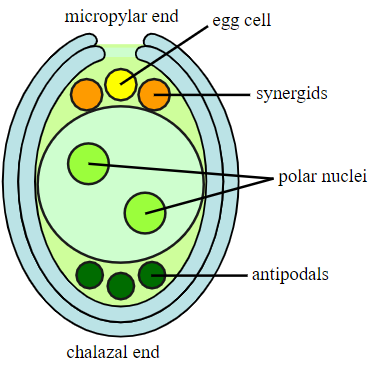
The second nuclei fusion with polar nuclei causes the formation of
Answer
473.1k+ views
Hint: Double fertilization is a unique feature of angiosperms which occurs when one male gamete fuses with the egg cell to produce diploid zygote while the other male gametes fuses with the diploid secondary nucleus that produces endosperm.
Complete answer:
The secondary nucleus is formed by the fusion of two polar nuclei in the embryo sac of a seed plant leading to fertilization. The secondary nucleus is also known as the primary endosperm nucleus. It is triploid (meaning three chromosomes set per nucleus) in some species. It borders the embryo and supplies nutrition in the form of starch though it can also contain oils and protein.
The cells of an unfertilized ovule are 8 in number and are arranged within the type of 3+2+3 i.e antipodal cells, polar central cells, synergids and ovum. One sperm fertilizes the sperm and another sperm sums up with the 2 polar nuclei of the big cell of the megagametophyte.
During the double fertilization in angiosperms one of the two males carried by the pollen tube fuses with the egg cell nucleus to form diploid zygote and the other with the diploid central cell nucleus to form endosperm. The first stage in the production of endosperm is called the cell proliferation, which gives the syncytium composed of many free nuclei within the cytoplasm. As endosperm form by fusion of a diploid nucleus and a haploid gamete is a triploid structure.
The haploid sperm and haploid egg gives the diploid zygote, and it is called syngamy, and the other sperm and two haploid polar nuclei of the middle cell of the megagametophyte form a triploid nucleus. Some plants may form the polyploidy nuclei. Therefore the correct answer is Endosperm.

Note: During nuclear endosperm production, the primary endosperm nucleus divides again and again without the wall formation (cytokinesis) and gives a large number of free nuclei. Nuclear endosperm is the most common type of endosperm in the flowers.
Complete answer:
The secondary nucleus is formed by the fusion of two polar nuclei in the embryo sac of a seed plant leading to fertilization. The secondary nucleus is also known as the primary endosperm nucleus. It is triploid (meaning three chromosomes set per nucleus) in some species. It borders the embryo and supplies nutrition in the form of starch though it can also contain oils and protein.
The cells of an unfertilized ovule are 8 in number and are arranged within the type of 3+2+3 i.e antipodal cells, polar central cells, synergids and ovum. One sperm fertilizes the sperm and another sperm sums up with the 2 polar nuclei of the big cell of the megagametophyte.
During the double fertilization in angiosperms one of the two males carried by the pollen tube fuses with the egg cell nucleus to form diploid zygote and the other with the diploid central cell nucleus to form endosperm. The first stage in the production of endosperm is called the cell proliferation, which gives the syncytium composed of many free nuclei within the cytoplasm. As endosperm form by fusion of a diploid nucleus and a haploid gamete is a triploid structure.
The haploid sperm and haploid egg gives the diploid zygote, and it is called syngamy, and the other sperm and two haploid polar nuclei of the middle cell of the megagametophyte form a triploid nucleus. Some plants may form the polyploidy nuclei. Therefore the correct answer is Endosperm.

Note: During nuclear endosperm production, the primary endosperm nucleus divides again and again without the wall formation (cytokinesis) and gives a large number of free nuclei. Nuclear endosperm is the most common type of endosperm in the flowers.
Latest Vedantu courses for you
Grade 10 | CBSE | SCHOOL | English
Vedantu 10 CBSE Pro Course - (2025-26)
School Full course for CBSE students
₹37,300 per year
Recently Updated Pages
Master Class 9 General Knowledge: Engaging Questions & Answers for Success

Master Class 9 English: Engaging Questions & Answers for Success

Master Class 9 Science: Engaging Questions & Answers for Success

Master Class 9 Social Science: Engaging Questions & Answers for Success

Master Class 9 Maths: Engaging Questions & Answers for Success

Class 9 Question and Answer - Your Ultimate Solutions Guide

Trending doubts
State and prove Bernoullis theorem class 11 physics CBSE

What are Quantum numbers Explain the quantum number class 11 chemistry CBSE

Who built the Grand Trunk Road AChandragupta Maurya class 11 social science CBSE

1 ton equals to A 100 kg B 1000 kg C 10 kg D 10000 class 11 physics CBSE

State the laws of reflection of light

One Metric ton is equal to kg A 10000 B 1000 C 100 class 11 physics CBSE




